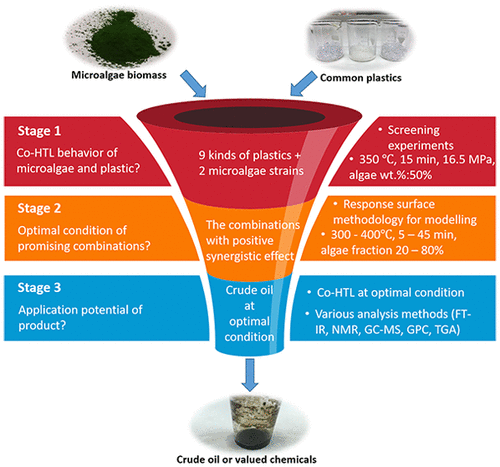当前位置:
X-MOL 学术
›
ACS ES&T Eng.
›
论文详情
Our official English website, www.x-mol.net, welcomes your
feedback! (Note: you will need to create a separate account there.)
Screening and Optimization of Microalgae Biomass and Plastic Material Coprocessing by Hydrothermal Liquefaction
ACS ES&T Engineering ( IF 7.4 ) Pub Date : 2021-11-06 , DOI: 10.1021/acsestengg.1c00261 Bingfeng Guo 1, 2 , Boda Yang 2 , Ying Su 3 , Shicheng Zhang 1, 4 , Ursel Hornung 2 , Nicolaus Dahmen 2
ACS ES&T Engineering ( IF 7.4 ) Pub Date : 2021-11-06 , DOI: 10.1021/acsestengg.1c00261 Bingfeng Guo 1, 2 , Boda Yang 2 , Ying Su 3 , Shicheng Zhang 1, 4 , Ursel Hornung 2 , Nicolaus Dahmen 2
Affiliation

|
In the past decade, microalgae biomass has been attracting considerable interest in valuable biocomponents and biofuel production. Meanwhile, plastic waste handling has become one of the most pressing global environmental concerns. Coprocessing of plastic waste and biomass has previously been reported to produce good quality fuel oil and high-value chemicals. In this study, we examined a coliquefaction process (co-HTL) of 2 microalgae, Chlorella vulgaris (Cv) and Nannochloropsis gaditana (Ng), with nine types of common plastics. In a first step, the co-HTL process was conducted in microautoclave reactors with a fixed algae/plastic mass ratio (50:50) at a temperature of 350 °C and a pressure of 16 MPa for a holding time of 15 min. Among the different types of plastics, positive synergistic effects between polycarbonate (PC), polystyrene (PS), and microalgae have been observed: (1) Plastics showed greater decomposition. (2) HTL crude oil yields were increased. Ng algae exhibits a higher interaction ability with plastics. Then, PC and PS were coprocessed with Ng algae using the response surface methodology to optimize the effects of temperature (300–400 °C), algae/plastic mass ratio (20:80–80:20), and holding time (5–45 min) on HTL crude oil yield. Software-based data analysis of the co-HTL experiments were conducted, and the optimal parameters were proposed, which were verified by the experiment results; Ng+PC (20:80 wt %) exhibits the highest crude oil yield of 67.2% at 300 °C with a 5 min holding time, while Ng+PS (80:20 wt %) generates 51.4 wt % crude oil yield at 400 °C and a 25 min holding time. Finally, the analytical results of elemental analysis, FTIR, 1H NMR, GPC, GC-MS, and TGA on the crude oil produced from pure microalgae HTL and co-HTL were compared, indicating that Ng+PC crude oil is more suitable for aromatic chemicals production and Ng+PS crude oil could be more favorable for biofuel applications.
中文翻译:

水热液化微藻生物质与塑料材料协同加工的筛选与优化
在过去的十年中,微藻生物质在有价值的生物成分和生物燃料生产方面引起了相当大的兴趣。与此同时,塑料废物处理已成为全球最紧迫的环境问题之一。据报道,塑料废物和生物质的协同处理可以生产优质燃料油和高价值化学品。在这项研究中,我们检查了 2 种微藻、小球藻(Cv) 和Nannochloropsis gaditana的共液化过程 (co-HTL)(Ng),有九种常见的塑料。在第一步中,在 350 °C 的温度和 16 MPa 的压力下,在具有固定藻类/塑料质量比 (50:50) 的微型高压釜反应器中进行共 HTL 过程,保持时间为 15 分钟。在不同类型的塑料中,已观察到聚碳酸酯 (PC)、聚苯乙烯 (PS) 和微藻之间的积极协同效应:(1) 塑料表现出更大的分解。(2) HTL原油收率提高。Ng藻类与塑料表现出更高的相互作用能力。然后,使用响应面法对 PC 和 PS 与 Ng 藻进行共处理,以优化温度 (300–400 °C)、藻/塑质量比 (20:80–80:20) 和保持时间 (5– 45 分钟)关于 HTL 原油产率。对 co-HTL 实验进行了基于软件的数据分析,并提出了最优参数,并通过实验结果进行了验证;Ng+PC (20:80 wt %) 在 300 °C 和 5 分钟保持时间下表现出最高的原油收率 67.2%,而 Ng+PS (80:20 wt%) 在 400 °C 下产生 51.4 wt % 的原油收率°C 和 25 分钟的保持时间。最后,元素分析的分析结果,FTIR,对比了纯微藻HTL和co-HTL生产的原油的1 H NMR、GPC、GC-MS和TGA,表明Ng+PC原油更适合芳烃化工生产,Ng+PS原油可以更有利于生物燃料的应用。
更新日期:2022-01-14
中文翻译:

水热液化微藻生物质与塑料材料协同加工的筛选与优化
在过去的十年中,微藻生物质在有价值的生物成分和生物燃料生产方面引起了相当大的兴趣。与此同时,塑料废物处理已成为全球最紧迫的环境问题之一。据报道,塑料废物和生物质的协同处理可以生产优质燃料油和高价值化学品。在这项研究中,我们检查了 2 种微藻、小球藻(Cv) 和Nannochloropsis gaditana的共液化过程 (co-HTL)(Ng),有九种常见的塑料。在第一步中,在 350 °C 的温度和 16 MPa 的压力下,在具有固定藻类/塑料质量比 (50:50) 的微型高压釜反应器中进行共 HTL 过程,保持时间为 15 分钟。在不同类型的塑料中,已观察到聚碳酸酯 (PC)、聚苯乙烯 (PS) 和微藻之间的积极协同效应:(1) 塑料表现出更大的分解。(2) HTL原油收率提高。Ng藻类与塑料表现出更高的相互作用能力。然后,使用响应面法对 PC 和 PS 与 Ng 藻进行共处理,以优化温度 (300–400 °C)、藻/塑质量比 (20:80–80:20) 和保持时间 (5– 45 分钟)关于 HTL 原油产率。对 co-HTL 实验进行了基于软件的数据分析,并提出了最优参数,并通过实验结果进行了验证;Ng+PC (20:80 wt %) 在 300 °C 和 5 分钟保持时间下表现出最高的原油收率 67.2%,而 Ng+PS (80:20 wt%) 在 400 °C 下产生 51.4 wt % 的原油收率°C 和 25 分钟的保持时间。最后,元素分析的分析结果,FTIR,对比了纯微藻HTL和co-HTL生产的原油的1 H NMR、GPC、GC-MS和TGA,表明Ng+PC原油更适合芳烃化工生产,Ng+PS原油可以更有利于生物燃料的应用。











































 京公网安备 11010802027423号
京公网安备 11010802027423号